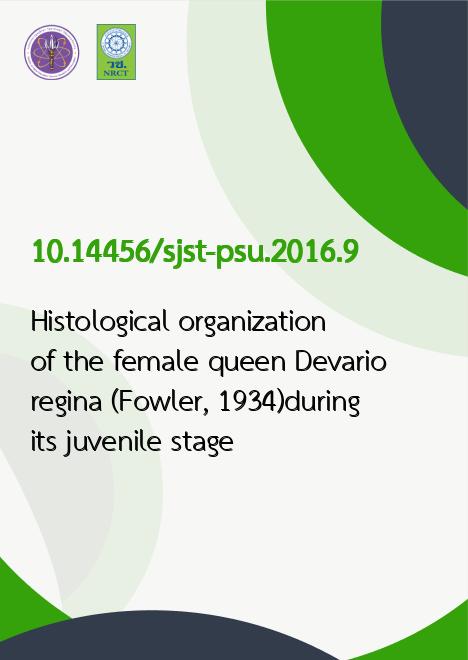
|
Histological organization of the female queen Devario regina (Fowler, 1934)during its juvenile stage |
|---|---|
| รหัสดีโอไอ | |
| Creator | 1. Piyakorn Boonyoung 2. Sinlapachai Senarat 3. Jes Kettratad 4. Pisit Poolprasert 5. Watiporn Yenchum 6. Waristha Angsirijinda |
| Title | Histological organization of the female queen Devario regina (Fowler, 1934)during its juvenile stage |
| Publisher | Research and Development Office, Prince of Songkla University |
| Publication Year | 2559 |
| Journal Title | Songklanakarin Journal of Science and Technology (SJST) |
| Journal Vol. | 38 |
| Journal No. | 1 |
| Page no. | 67-72 |
| Keyword | Devario regina (Fowler, 1934),histochemistry,histology,systems,Thailand |
| ISSN | 0125-3395 |
| Abstract | Limited research has been reported in the basic information about the structural organizations of fish organs in theirjuvenile state that could be used as histopathological biomarkers. Thus, the histological structures of important organs ofthe female fish Devario regina (Fowler, 1934) during its juvenile stage were exclusively examined using histological andhistochemical approaches. Specimens were collected during the fishing season (July and October 2010) from the Tapee river,Thailand. Using histological analysis, the digestive system was distinctly composed of two parts; the digestive tract andaccessory organs (liver and pancreas). Based on their histological structure, the epithelial organization of the oral cavity andpharynx was lined by stratified epithelium whereas the intestine was covered by a simple columnar epithelium and containedseveral goblet cells. The goblet cells were negatively stained with hematoxylin and eosin (H&E) and Masson's Trichrome(MT). In contrast, they were positively stained with Periodic Acid Schiff reaction (PAS) and aniline blue (AB). The liver tissuein this fish was composed of polyhedral hepatocytes, with their sinusoids being distinctly located between the hepatocytes.The sinusoids were lined by a simple squamous epithelium. The pancreatic parenchyma mainly consisted of pyramidal cellsthat rested on a basal lamina in the acinar. Moreover, the pancreatic cells had a basophilic cytoplasm, a distinct basal nucleusand contained large eosinophilic zymogen granules. The excretory system especially referred to the kidney, and was composedof renal tubules and hematopoietic tissue. The female reproductive system was the ovary that was surrounded by a tunicaalbuginea. The ovary contained oocytes at differential stages of development including oogonia and the previtellogenic stage.Finally, the integument of this species consisted mainly of three layers of epidermis, dermis and hypodermis, respectively |
